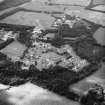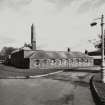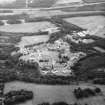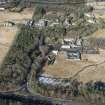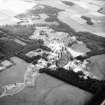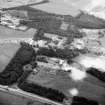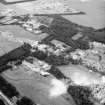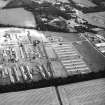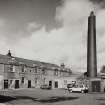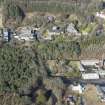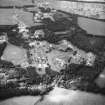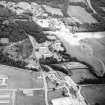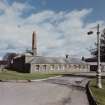Dechmont, Bangour Village Hospital, Maintenance Block, Power Station And Workshops
Generator House (20th Century), Psychiatric Hospital (20th Century), Workshop(S) (20th Century)
Site Name Dechmont, Bangour Village Hospital, Maintenance Block, Power Station And Workshops
Classification Generator House (20th Century), Psychiatric Hospital (20th Century), Workshop(S) (20th Century)
Alternative Name(s) Boiler House
Canmore ID 248468
Site Number NT07SW 18.31
NGR NT 03215 70728
NGR Description Centred NT 03215 70728
Datum OSGB36 - NGR
Permalink http://canmore.org.uk/site/248468
- Council West Lothian
- Parish Ecclesmachan
- Former Region Lothian
- Former District West Lothian
- Former County West Lothian
Largely single storey with 2-storey range to N. Complex of plant buildings forming double courtyard-plan and including former power station with tall, circular brick chimney stack to E and row of 2-storey workshops to N. Situated at the entrance to the site. Rubble with ashlar margins; some concrete render. Raised cills. Base course, cornice. Variety of window and door openings; some round-arched. Later gabled shed to SW with corrugated iron roof.
Bangour Village Hospital is the best surviving example in Scotland of a psychiatric hospital created in the village system of patient care, a revolutionary concept in the late 19th century. The former power station and workshops are situated at the entrance to the former hospital, and are key buildings within the site, servicing the operational needs of the institution as well as contributing to the rehabilitation of patients. Buildings with utilitarian functions and incorporating workshops within hospital settings are rare survivors and this one is largely externally unaltered. With its tall red brick chimney stack, the buildings make an eye-catching and significant contribution to the complex as a whole and there is some decorative detailing to the window margins and to the dormers of the north elevation. The complex enabled the hospital site to be self-sufficient in electricity and was a vital part of the village philosophy of the hospital. The workshops at the north side provided employment for the male patients in the hospital and included a painter, smith, cabinetmaker, upholsterer, plumber, carpenter and shoemaker. The boiler house and dynamo room were situated to the far east of the site and the south elevation comprised coal and wood sheds. The coal was delivered by the adjoining train station and delivered directly to the shed via shutes. Steam produced here was used to power the laundry, kitchen and bakery and the electricity generated was used for the whole hospital. The engineer's house was situated close by and is the current Gateway Cottage. The buildings of the hospital sit within their original rural setting and remain largely externally unaltered. Designed in a restrained Scots Renaissance style, Bangour Village Hospital is an outstanding remaining example of a psychiatric hospital built as a village and espousing a complete philosophy of care. The village system of patient care, exemplified by the Alt-Scherbitz hospital, near Leipzig in Germany in the 1870s encouraged psychiatric patients to be cared for within their own community setting, where there were few physical restrictions and where village self-sufficiency was encouraged. This was in contrast to the large contemporary asylum buildings. This philosophy had been gradually developing in a number of Scottish institutions, but Bangour saw its apotheosis, specifically in relation to psychiatric patients. Two other hospitals were built in Scotland for psychiatric patients, Kingseat, to the north of Aberdeen (built in 1904) and Dykebar Hospital in Paisley, 1909 (see separate listing). These have not survived as completely as Bangour. The hospital was built by the well-known Edinburgh architect Hippolyte J Blanc as a result of a competition begun in 1898. The Edinburgh Lunacy Board had concluded that a new psychiatric hospital was required to cater for the increasing numbers of patients from Edinburgh and the hospital was opened in 1906, with some of the buildings still to be completed. It was designed with no external walls or gates. The utility buildings were positioned at the centre of the site, the medical buildings for patients requiring medical supervision and treatment were to the E and there were villas to the W of the site which could accommodate patients who required less supervision and were able to work at some sort of industry. The complex also included a farm to the NW (not part of current site) and had its own water and electricity systems and also had its own railway. The hospital was commissioned by the War Office in WWI for wounded soldiers and extra temporary structures were erected. Most of which were dismantled after the War although some timber ones were retained by the hospital. The railway too was dismantled in 1921. The patients returned in 1922. The hospital was commissioned again for WWII. At this time many temporary shelters were erected to the NW of the site and this became the basis of the Bangour General Hospital (now demolished). Bangour Village Hospital continued as a psychiatric hospital until 2004.
Hippolyte J Blanc (1844-1917) was an eminent and prolific Edinburgh-based architect who was perhaps best known for his Gothic revival churches. He was also a keen antiquarian and many of his buildings evoke an earlier Scottish style. (Historic Scotland)




















